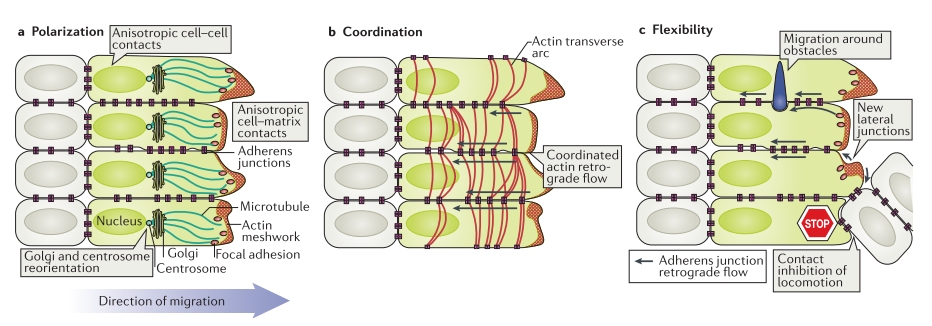Mayor, Roberto, and Sandrine Etienne-Manneville. “The front and rear of collective cell migration.” Nature Reviews Molecular Cell Biology (2016).
Summary & Highlights
- Collectively migrating group of cells is that it migrates more efficiently than if cells were isolated
- Cells become leaders in response to
external cues, which include the ECM, soluble factors and neighbouring cells - Moreover, ECM fibres control the migration of multi- cellular streams in vivo by providing directional cues
- Beta1-integrains
- Recruitment & activation of CDC42/RAC through adaptor proteins associated with GEFs such as SCRIB, BPIX or PAR3 and TAMI; and intracellular kinase FAK and SRC
- Downstream effectors: SCAR-WAVE complex
- Polarized intracellular organization of the leader cells promotes positive feedback loops and contributes to the stabilization of the polarized cell state
- When large sheets/clusters migrating, leader cells are linked together by adhesive structures (adherens junction)
- Adherens Junctions
- Cadherins = main transmembrane component, control actin and microtubule via catenins
- Anisotropic distribution of adherens induces anisotropic distribution of focal adhesions
- Transverse acto-myosin cables contribute to multicellular actin network
- Continuous acto-myosin drive retrograde flow along lateral sides
- Treadmilling! Cadherens recycled toward leading edge
- Transmission of information to the followers
- Leader cells not only explore the tissue environment and identify the migration path, they also significantly contribute to the directed migration of the followers.
- ECM secretion of leader cells can be different
- Mechanotransducers undergo a conformational change upon stretching, revealing new protein-interaction domains and inducing biochemical signalling, which in turn can modulate the strength of adhesion.
- **Merlin is involved in mechanotransduction during collective migration
- Translocates from cell-cell contact to cell cytoplasm to support polarization of RAC1 & lamellipodium formation
- Antagonistic relationship between cadherin-mediate junctions & integrin-based adhesions
- Followers can directly participate in generating pulling forces far away from leader cells; long-range transmission
- Followers play an important role
- One role is phenomenon of contact inhibition of locomotion (CIL)
- Two migrating cells, upon collision, halt their forward locomotion by collapsing protrusions at the site of contact and establishing protrusions away from each other
- 1. Sense contact with other cells
- 2. Signal transmitted from surface to inside cell
- 3. Intracellular signals drive protrusion collapse at cell contact & repolarize with new protrusions away from cell contract
- Cadherins, ephrins & EPH receptors, plane planar cell polarity pathway
- Chemotaxis– source and sink of chemical
- Cells can generate their own gradient!
Future Questions
- Are the links that leader cells make with each other different from the links formed between leader cells and non-leader?
- Do multiply attached leader cells generate more forces?
- Is the ECM secreted by leader cells different from follower cells?
- Define role of leader and followers in collective cell migration!
- Why doesn’t CIL occur when invadopodia migrate out?
- Do cells with invadopodia divide?
- Molecular basis of CIL is still lacking!
Personal Thoughts
